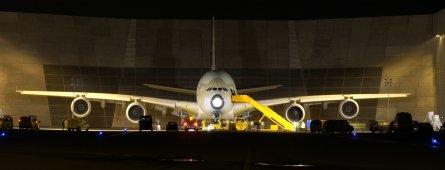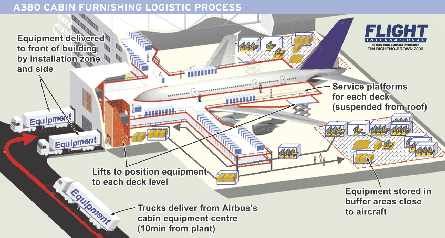Max Kingsley-Jones / Hamburg
Airbus’s Hamburg Finkenwerder plant has undergone an incredible transformation over the last six years as part of the manufacturer’s preparations for A380 production. By the time series production of the ultra-large aircraft gets into its stride next year, the plant’s gross area will have more than doubled – thanks to the reclamation of land from the nearby river Elbe – its factory space tripled, its runway extended by almost 1km (0.6 miles) and its employee count increased by 50%.
Finkenwerder already has responsibility for the construction and equipping of the rear-fuselage sections for all Airbus aircraft. The plant also carries out cabin furnishing for all Airbus single-aisle (A320 family) aircraft and operates one of the two A320 family final-assembly line centres. The latter is well into its ramp-up to enable it to produce half the 32 aircraft a month it expects to output next year in conjunction with the A320 sister line in Toulouse. The plant is also the headquarters for Airbus’s cabin and cargo customisation centre of excellence, which was set up two years ago to initially cater for A380 customer requirements, but is expanding to cover all aspects of the business.
Rapid growth
Although its location next to the Elbe arguably made Finkenwerder a more logical choice than Toulouse to have the final-assembly line for the A380 (the A380’s huge subassembly transport ship docks right next to the plant), the reality was always that the glittering prize of A380 assembly would be allocated to the site of Airbus’s headquarters in France. But Airbus Deutschland’s “compensation package” was impressive – the division is responsible for the structural and final assembly of the A380’s forward- and rear-fuselage sections and the vertical tailplane (it builds the fin and undertakes the assembly incorporating the Spanish-built rudder and dorsal fairing) flaps, as well as cabin furnishing and painting. It will also be responsible for customer deliveries to airlines in Europe and the Middle East.
A380 work has been allocated across all the Airbus Deutschland plants, which will see the division’s headcount reach 22,000 by next year. But the bulk of A380 work is centred at Finkenwerder, which began a €1.3 billion expansion in 2000 (of which €650 million was for A380 infrastructure) that is due to be completed next year. But the expansion effort has had problems, with local opposition to the reclamation of the Mühlenberger loch (which is adjacent to one of Hamburg’s most exclusive suburbs), as well as the runway extensions. These issues have been overcome, with the last piece of the jigsaw, the second, 589m (1,930ft) runway extension to the south, due to be completed next year in parallel with the construction of the delivery centre.
“Employee numbers at Finkenwerder will reach 12,000 at their peak next year – this is up by around 4,000 from the start of the decade, of which 2,500 are for the A380,” says Dr Ulrich Weber, Airbus vice-president site management Hamburg. This excludes another 4,000 people who work at the plant for non-Airbus companies, he adds. Weber says that in general it has not been a problem to source new employees for the expansion in Hamburg, although he concedes that the skill profile is a factor: “It depends whether it is blue collar worker for the A380 production ramp-up, or an engineer for the A380 cabin. It’s quite difficult to find highly qualified engineers at the moment.”
Before the A380 expansion, the Finkenwerder site had a gross area of 1,670,000m2 (17,975,000ft2), of which 118,000m2 accounted for production facilities. Land reclamation boosted the plant’s area 3,100,000m2 and the additional hangars and buildings completed have pushed the production area to 400,000m2. The initial runway extension saw 363m added to the north, with work completed in 2004. Once the runway is modifified its full length will be 3,273m. It will also have been widened from 45m to 70m.
| Hamburg Finkenwerder Expansion 2000-7 |
 |
Ten buildings/constructions have been (or are about to be) completed as part of Finkenwerder’s recent expansion, including (see graphic above):
■ A380 major component assembly (MCA) hall (where structural and final assembly of forward and aft fuselages is undertaken);
■ Two A380 cabin-furnishing halls (one four-bay hangar and one two-bay hangar)
Two-bay A380 painting hall (including fin paint shop);
■ Two-bay A380 flightline hangar;
■ A380 despatch building (to handle flights from/to Toulouse for customisation);
■ A380 delivery centre;
■ A380 run-up bay;
■ A330 multifunctional hangar;
■ Roll-on/roll-off dock for A380 sub-assembly transport ship.
Station to station
With Airbus’s initial plans for A380 production aiming for a maximum output of four a month once it stabilises, infrastructure has been designed in a way that each building could be replicated in a mirror image to enable the rate to be doubled. However, during the planning stage Airbus has decided to go ahead and build some of that additional infrastructure (for example the second furnishing hangar that initially has two bays and could eventually be expanded to four). Part of what could eventually be the second MCA hall has been completed – dubbed the multifunctional hangar, it will be used initially to carry out A330/A340 (and later A350) equipping of subassemblies as part of the plant modernisation effort.
The MCA hall came into operation in 2003, while the furnishing hall began functioning late last year when the first of two A380 cabin test aircraft, MSN002, arrived for outfitting and painting. Two of the four bays in this hangar are already running. While work on the first aircraft is finished, the second A380 cabin test aircraft, MSN007, is undergoing cabin installation and the first customer aircraft, MSN003 (for launch operator Singapore Airlines), was due to be ferried to Finkenwerder from Toulouse last week.
 |
| A380s arrive from Toulouse for cabin insulation and painting |
“We will also receive [the second SIA aircraft] MSN005 this year and three more aircraft in the first quarter of 2007,” says Airbus senior manager A380 cabin furnishing Dieter Stein. “Station five and six in the second furnishing hall are due to be ready by the beginning of next year,” he adds.
Given the scale of the A380 cabin installation exercise – two full passenger decks and potentially seats and facilities to fit for over 600 passengers – Airbus has completely reinvented how it goes about the job.
Fully furnished
Stein, who has been involved with the A380 since 1997, when it was the A3XX project, says the cabin-installation processes were a central part of the A380’s design, right from the start: “We had production process planners located in the design office to give inputs on how to make production-optimised design for components and cabin installation for the big monuments like galleys, toilets, stairs, lifts etc.”
He adds: “We divided the aircraft into 10 installation zones – four in each passenger cabin between the doors, and two for the cargo holds. We asked the cabin design engineers to adapt the structure to our zone concept – we have never succeeded in getting involved that early in the process before.”
The new concept has all the facets of the installation process – deliveries from suppliers, engineering drawings and employees – dedicated to each zone. “This enables us to install furnishings independently in one zone from another – in the past, one missing sidewall panel could hold up the whole process throughout the cabin.”
The design of the furnishing halls was focused on the logistic process. “We have no storage area on site, it is held at our cabin equipment centre, which is 10min by truck from the plant,” says Stein. He adds that the length of the bays will enable any future stretch of the aircraft to be accommodated without modification.
Trucks deliver the furnishings directly to the front of each bay, sorted by left and right side and by installation zone, with lifts to transport the components to the relevant deck.
 |
| Land reclaimed from the Elbe river has doubled the plant's area |
Ramping up
Airbus designed the bays so that the aircraft is jacked 1.5m off the ground during the installation process. This eliminates problems with the aircraft’s deck height changing as more furnishings are installed and enables all areas of the aircraft to be accessed during the furnishing process, says Stein. Unlike existing programmes, which use fixed platforms, the three levels of working platforms for the A380 are suspended from the hangar ceiling. “This means that there is 120t of platforms hanging from the roof on each side,” says Stein. “When the aircraft is docked in or out we raise the platforms out of the way.”
| A380 cabin Furnishing logistic process |
 |
Around 150 people are employed in A380 furnishing and this will grow to 300 by the time the second hall opens. “We do not believe we will need many more people as we ramp up, as we are progressing along the learning curve and will need fewer people per aircraft than we do now,” says Stein. “We plan to have 20 working days lead time when we reach the 100th aircraft for follow-on aircraft, and 25 days for head of version,” he adds.
The result is that A380 process will be faster than that for the A330/A340 in Toulouse. Stein believes there several factors make this possible: “We have access through 16 doors – far more than on the A330/A340 – and this is critical.” He adds that the platform design for the A380 is also a factor, while the installation zone concept gives an advantage as it will eliminate potential bottlenecks.
So the new installation process is clearly advantageous in theory, but Stein concedes it still needs to be refined following the experiences with the first furnishing effort using MSN002. “The logistic processes are not yet running as planned. We have to learn a lot and have to make the people to change their mindset to cope with the new processes,” he says.
“Following the experience with MSN002, we are looking at how we qualify again the employees for the new processes – we have to understand why some people didn’t want to use some of the new processes and ask ‘have we overlooked some good elements of the old system?’,” adds Stein.
Once production is in full swing next year, after interior installation and painting, A380s will either be ferried back to Toulouse for customer acceptance, or transferred to the Hamburg delivery centre depending on its destination.
Parallel goals
The wrangle over the southern runway extension – necessary to enable A380s to carry out take-offs at maximum weight during customer acceptance test flights – has delayed the plans for the German delivery centre, but this is now due to be completed in 2007, says Weber.
“We will set up the delivery centre in parallel with the completion of the runway extension during the course of next year,” says Weber. He adds that Airbus is yet to decide if initial deliveries to the first Middle Eastern customer – Emirates – in the second quarter of next year will be made from Toulouse or Hamburg.
Source: Flight International
















